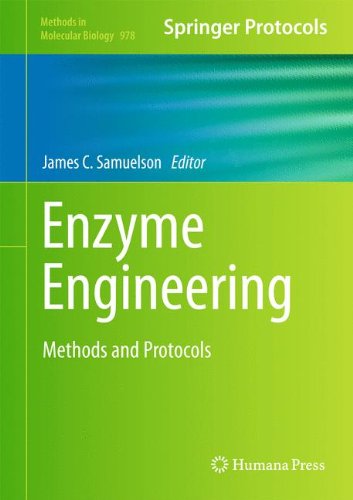Enzyme Engineering Methods and Protocols 1st Edition by James C Samuelson ISBN 1627032924 978-1627032926
$50.00 Original price was: $50.00.$35.00Current price is: $35.00.
Enzyme Engineering Methods and Protocols 1st Edition by James C Samuelson – Ebook PDF Instant Download/Delivery:1627032924 , 978-1627032926
Full download Enzyme Engineering Methods and Protocols 1st Edition after payment

Product details:
ISBN 10: 1627032924
ISBN 13: 978-1627032926
Author: James C Samuelson
Whether the pursuit is commercially motivated or purely academic, engineering a novel biological catalyst is an enticing challenge. High-resolution protein structure analysis allows for rational alteration of enzyme function, yet many useful enzyme variants are the product of well-designed selection schemes or screening strategies. Enzyme Engineering: Methods and Protocols provides guidance to investigators wishing to create enzyme variants with desired properties. This detailed volume covers such topics as a simple method for generating site-specific mutations within bacterial chromosomes. It also highlights the engineering of two difference types of rare-cutting endonucleases that show great potential in gene therapy applications: The newest development is the emergence of TAL effector nucleases or TALENs. Chapters describe newly developed technologies in sufficient detail so that each method can be practiced in a standard molecular biology laboratory. Written in the successful Methods in Molecular Biology™ series format, chapters include introductions to their respective topics, lists of the necessary materials and reagents, step-by-step, readily reproducible protocols, and notes on troubleshooting and avoiding known pitfalls.
Authoritative and easily accessible Enzyme Engineering: Methods and Protocols will be valuable for scientists with a budding interest in protein engineering as well as veterans looking for new approaches to apply in established discovery programs.
Table of contents:
I. Protein Variant Generation & Mutagenesis
Techniques for creating diversity in protein sequences:
-
A Tripartite Fusion System for the Selection of Protein Variants with Increased Stability in vivo
-
In vitro Evolution of Enzymes
-
Residue-Specific Incorporation of Unnatural Amino Acids into Proteins In vitro and In vivo
-
Reconstructing Evolutionary Adaptive Paths for Protein Engineering
-
Oligonucleotide Recombination Enabled Site-Specific Mutagenesis in Bacteria
-
Protein Engineering: Single or Multiple Site-Directed Mutagenesis
-
Gene Assembly and Combinatorial Libraries in S. cerevisiae via Reiterative Recombination
-
Promiscuity-Based Enzyme Selection for Rational Directed Evolution Experiments
-
Rational Protein Sequence Diversification by Multi-Codon Scanning Mutagenesis
II. Cloning & DNA Assembly
Methods for assembling genetic material and preparing it for expression:
-
FX Cloning: A Versatile High-Throughput Cloning System for Characterization of Enzyme Variants
-
Gene Synthesis by Assembly of Deoxyuridine Containing Oligonucleotides
III. Expression & Screening Systems
Systems used to express engineered proteins and screen for desired traits:
-
GFP Reporter Screens for the Engineering of Amino Acid Degrading Enzymes from Libraries Expressed in Bacteria
-
Screening Libraries for Improved Solubility: Using E. coli Dihydrofolate Reductase as a Reporter
-
In Vitro Directed Evolution of Enzymes Expressed by E. coli in Micro-Titre Plates
IV. DNA Targeting & Editing
Tools to modify or study DNA-protein interactions:
-
Flow Cytometric Assays for Interrogating LAGLIDADG Homing Endonuclease DNA Binding and Cleavage Properties
-
TAL Effector Nuclease (TALEN) Engineering
V. Enzyme Characterization
Technique for measuring enzyme activity and kinetics:
-
Determining Enzyme Kinetics via Isothermal Titration Calorimetry
VI. Protein Complex Assembly
Approaches to assemble multimeric protein complexes:
-
Use of Sulfolobus solfataricus PCNA Subunit Proteins to Direct the Assembly of Multimeric Enzyme Complexes
People also search for:
modern computational methods for rational enzyme engineering
enzyme engineering course
an enzyme definition
engineering new catalytic activities in enzymes
Tags: James C Samuelson, Enzyme Engineering, Methods, Protocols 1st



